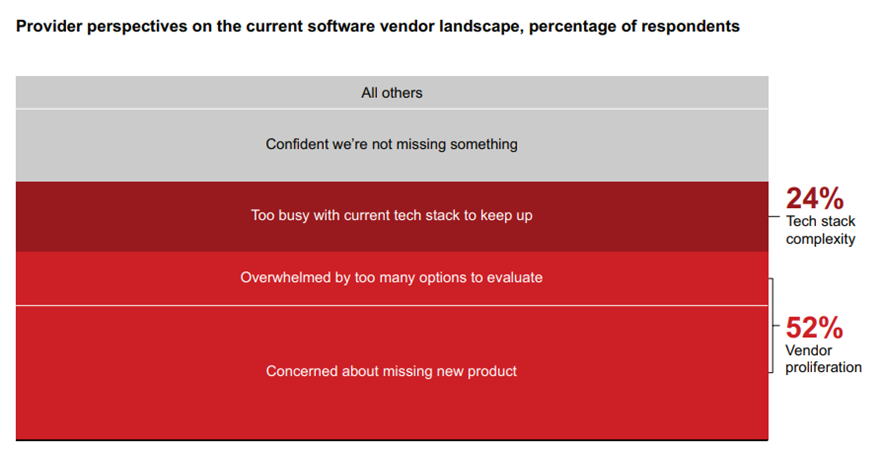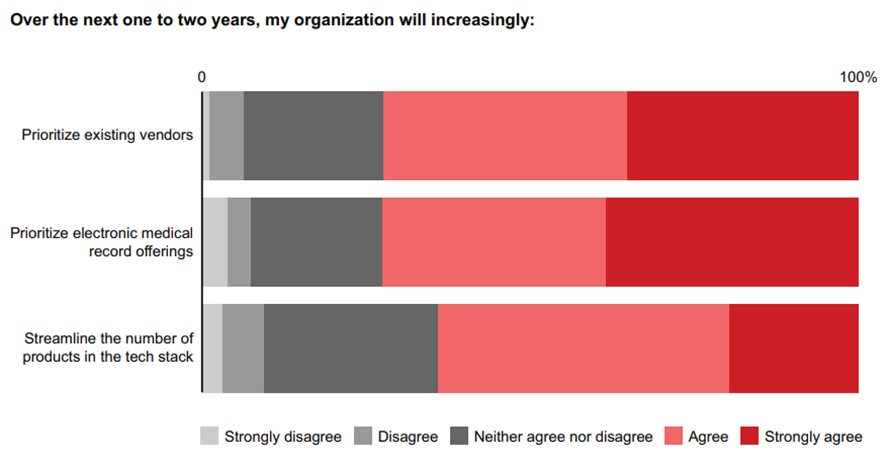The top pain points for providers with health IT vendors are: (1) interoperability, and (2) EMR integration — Offerings management is an issue.
Executive Summary by:
Joaquim Cardoso MSc.
health systems transformation — center of excellence
October 22, 2022
Executive Summary:
More than 50% of providers are struggling with the flood of offerings in the market:
- They cite concerns about missing high-impact new solutions
- or simply feeling overwhelmed by the number of offerings to evaluate.
- Additionally, during the pandemic, many providers adopted new technology solutions across a broad set of clinical and operational areas. As a result, many are emerging from Covid-19 with greater complexity in their tech stacks than ever before.
Interoperability and electronic medical record integration are top pain points for providers with their existing third-party tech stacks
Providers are responding to these challenges in various ways
- Many plan to increasingly look to existing vendors with proven solutions before considering offerings from new vendors (around 72% of providers).
- Second, and more specifically, many plan to look to their EMRs for new solutions before looking to others (around 71% of providers).
- While provider tech stacks have become larger and more sophisticated, EMRs remain the single most critical software solution for most providers.
- Many providers are taking a second look at new or enhanced offerings from their EMRs in areas such as telehealth.
Thirdly, some providers are making plans to streamline the number of third-party software solutions in their tech stacks over the next year (around 63% of providers).
Infographic

ORIGINAL PUBLICATION (excerpt)

How providers spend is evolving: The impact of vendor proliferation and complex tech stacks
While the outlook for provider software investments is strong, vendor proliferation and expanding tech stacks are driving changes in how providers plan to make software investments over the next year.
According to our research, more than 50% of providers are struggling with the flood of offerings in the market:
- They cite concerns about missing high-impact new solutions
- or simply feeling overwhelmed by the number of offerings to evaluate.
… more than 50% of providers are struggling with the flood of offerings in the market: (1) they cite concerns about missing high-impact new solutions; (2) or simply feeling overwhelmed by the number of offerings to evaluate.
Additionally, during the pandemic, many providers adopted new technology solutions across a broad set of clinical and operational areas. As a result, many are emerging from Covid-19 with greater complexity in their tech stacks than ever before.
Additionally, during the pandemic, many providers adopted new technology solutions across a broad set of clinical and operational areas.
As a result, many are emerging from Covid-19 with greater complexity in their tech stacks than ever before.
In fact, a quarter of all providers claim that their existing tech stacks keep them too busy to stay current on new offerings in the market (see Figure 7).

Providers see challenges with vendor proliferation and an increase in tech stack complexity

Figure 8, Sources: Provider interviews; Bain-KLAS 2022 Provider Executive Survey (N=289)
Tangentially, providers cite lack of cross-solution interoperability and poor EMR integration with existing tech stacks as some of the top pain points with their existing tech stacks, further illustrating the unique challenge of the current environment (see Figure 8).

Interoperability and electronic medical record integration are top pain points for providers with their existing third-party tech stacks

Sources: Provider interviews; Bain-KLAS 2022 Provider Executive Survey (N=289)
While the 21st Century Cures Act offers some promise for beginning to address these issues, material change has not yet occurred, and many providers remain skeptical about whether this regulation will bring about a real shift.

Providers are responding to these challenges in various ways
- Many plan to increasingly look to existing vendors with proven solutions before considering offerings from new vendors (around 72% of providers).
- Second, and more specifically, many plan to look to their EMRs for new solutions before looking to others (around 71% of providers).
While provider tech stacks have become larger and more sophisticated, EMRs remain the single most critical software solution for most providers.
Our research shows that many providers are taking a second look at new or enhanced offerings from their EMRs in areas such as telehealth. - Thirdly, some providers are making plans to streamline the number of third-party software solutions in their tech stacks over the next year (around 63% of providers).
How providers are responding to rising vendor proliferation and increasing complexity in their tech stacks

Sources: Provider interviews; Bain-KLAS 2022 Provider Executive Survey (N=289)





